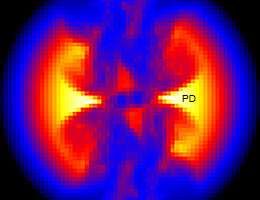Brown dwarfs are formed in the same way as sun-like stars

Astronomers have discovered a so-called proto-disc around the proto-brown dwarf Mayrit. With this discovery, they were able to confirm for the first time that this celestial body was formed in the same way as sun-like stars.
Brown dwarfs are celestial bodies whose characteristics are between those of stars and planets: their mass is too small to maintain the process of hydrogen fusion—the characteristic process for a star. On the other hand, they are significantly more massive than big planets; they possess about ten times the mass of Jupiter or more. This mass is sufficient to bring about a deuterium fusion in the core. That is why, when they are young, they can shine like faint stars. Although brown dwarfs frequently occur in the universe, they are difficult to examine and investigate. In particular, their formation is a subject of controversial debate. For the first time the LMU astronomer Basmah Riaz has now verified a so-called pseudo-disc around a proto-brown dwarf together with Masahiro Machida (Kyushu University, Japan) and Dimitris Stamatellos (University of Central Lancashire, Great Britain)—further proof that brown dwarfs emerge according to the same rules as "true" stars. The scientists report their results in the trade journal Monthly Notices of the Royal Astronomical Society.
"A decade ago, a model was already developed in which brown dwarfs are formed, like normal stars, through the collapse of a cloud of gas and dust. However, so far there had been no observation data that confirm this," says Riaz. The model predicts that a pseudo-disc of a certain size, mass and shape must emerge around the brown dwarf. The formation of the star essentially takes place in three consecutive phases. First, the proto-star is deeply embedded in a thick shroud of gas and dust. Then this cloud begins to disperse and slowly forms a disc-like structure, the pseudo-disc. Eventually only a disc remains and there is no more cloud. Using the data from the Atacama Large Millimeter/Submillimeter Arrays (ALMA) – an international radio telescope observatory in the Chilean Andes—Riaz's team has succeeded in proving for the first time that there is in fact such a pseudo-disc around the proto-brown dwarf Mayrit 1701117. "It is particularly exciting that we received both the signals of the collapsing gas cloud as well as the forming pseudo-disc," says Riaz. "Thus our data confirm the model and show that brown dwarfs go through the same stages of development as stars similar to the sun." In addition, the scientists were able to not only prove the existence of the pseudo-disc, but also to identify its age: it was most likely formed 30,000 to 40,000 years ago—in cosmic terms, the birth of Mayrit 1701117 is still at a very early stage."
More information: B Riaz et al. ALMA reveals a pseudo-disc in a proto-brown dwarf, Monthly Notices of the Royal Astronomical Society (2019). DOI: 10.1093/mnras/stz1032
Journal information: Monthly Notices of the Royal Astronomical Society
Provided by Ludwig Maximilian University of Munich




















